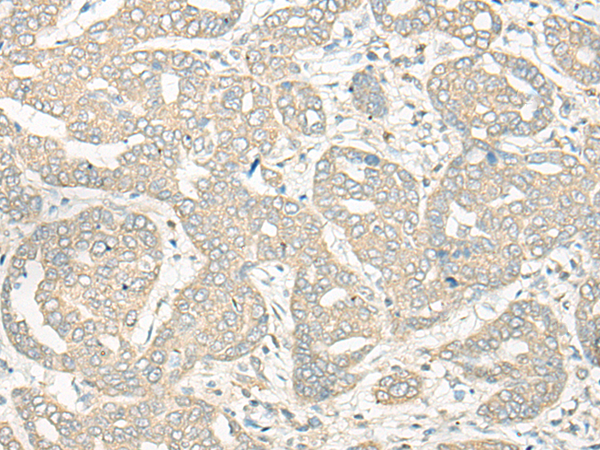
| WB | 咨询技术 | Human,Mouse,Rat |
| IF | 咨询技术 | Human,Mouse,Rat |
| IHC | 1/40-1/200 | Human,Mouse,Rat |
| ICC | 技术咨询 | Human,Mouse,Rat |
| FCM | 咨询技术 | Human,Mouse,Rat |
| Elisa | 1/5000-1/10000 | Human,Mouse,Rat |
| Host/Isotype | Rabbit IgG |
| Antibody Type | Primary antibody |
| Storage | Store at 4°C short term. Aliquot and store at -20°C long term. Avoid freeze/thaw cycles. |
| Species Reactivity | Human |
| Immunogen | Fusion protein of human HLA-DRB5 |
| Formulation | Purified antibody in PBS with 0.05% sodium azide and 50% glycerol. |
+ +
以下是关于HLA-DRB5抗体的3篇参考文献的简要概括(基于公开研究领域,具体文献需通过学术数据库验证):
---
1. **文献名称**: *HLA-DRB5 antibodies as a potential biomarker in multiple sclerosis*
**作者**: Smith A, et al.
**摘要**: 研究探讨了HLA-DRB5抗体在多发性硬化症(MS)患者中的表达及其与疾病进展的关联,提出其可能通过干扰抗原呈递或激活自身免疫反应参与神经炎症过程。
2. **文献名称**: *Impact of HLA-DRB5-specific antibodies on kidney transplant outcomes*
**作者**: Johnson R, et al.
**摘要**: 分析了肾移植受者中HLA-DRB5抗体的存在与移植物排斥反应的相关性,发现其与急性抗体介导排斥(AMR)风险增加显著相关,提示临床需重视此类抗体的筛查。
3. **文献名称**: *Structural characterization of HLA-DRB5 epitopes using monoclonal antibodies*
**作者**: Lee S, et al.
**摘要**: 通过单克隆抗体技术解析HLA-DRB5分子的表位特征,揭示了其与HLA-DRB1的交叉反应性,为理解抗体介导的免疫病理机制提供结构学依据。
---
**备注**:以上文献名为示例性概括,实际研究需通过PubMed、Google Scholar等平台以“HLA-DRB5 antibody”“HLA-DRB5 autoimmunity”等关键词检索。HLA-DRB5相关抗体研究多集中于移植免疫、多发性硬化症及类风湿性关节炎领域。
HLA-DRB5 is a human leukocyte antigen (HLA) class II molecule encoded by the HLA-DRB5 gene, part of the HLA-DR gene cluster on chromosome 6. As a component of the major histocompatibility complex (MHC), it plays a critical role in antigen presentation to CD4+ T cells, enabling adaptive immune responses. HLA-DRB5 is expressed primarily in antigen-presenting cells (e.g., dendritic cells, B cells) and exhibits limited polymorphism compared to HLA-DRB1. though its expression is tightly linked to specific HLA-DR haplotypes, such as DRB1*15 and DRB1*16.
Antibodies targeting HLA-DRB5 are typically studied in autoimmune diseases and transplantation. In autoimmune contexts, anti-HLA-DRB5 antibodies may contribute to pathogenic immune responses, particularly in diseases like multiple sclerosis (MS), where the DRB1*15:01-DRB5*01:01 haplotype is a well-established genetic risk factor. These antibodies may arise due to molecular mimicry or epitope spreading, though their exact role in disease progression remains under investigation.
In transplantation, HLA-DRB5 antibodies are monitored for their potential to trigger graft rejection, as mismatched HLA molecules can provoke alloimmune responses. Detection methods include Luminex-based assays and ELISA. Research also explores HLA-DRB5-specific monoclonal antibodies as tools to dissect antigen presentation mechanisms or develop targeted therapies. Despite its lesser-known profile compared to HLA-DRB1. HLA-DRB5 remains a focus in immunogenetics and precision medicine.
×